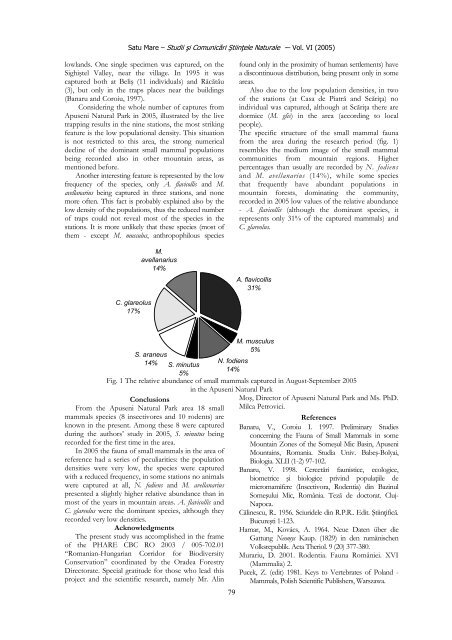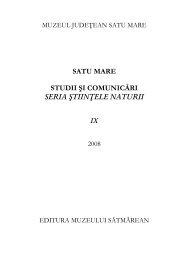Referenţi ştiinţifici - Muzeul Judeţean Satu Mare
Referenţi ştiinţifici - Muzeul Judeţean Satu Mare
Referenţi ştiinţifici - Muzeul Judeţean Satu Mare
Create successful ePaper yourself
Turn your PDF publications into a flip-book with our unique Google optimized e-Paper software.
<strong>Satu</strong> <strong>Mare</strong> – Studii şi Comunicări Ştiinţele Naturale -– Vol. VI (2005)<br />
lowlands. One single specimen was captured, on the<br />
Sighiştel Valley, near the village. In 1995 it was<br />
captured both at Beliş (11 individuals) and Răcătău<br />
(3), but only in the traps places near the buildings<br />
(Banaru and Coroiu, 1997).<br />
Considering the whole number of captures from<br />
Apuseni Natural Park in 2005, illustrated by the live<br />
trapping results in the nine stations, the most striking<br />
feature is the low populational density. This situation<br />
is not restricted to this area, the strong numerical<br />
decline of the dominant small mammal populations<br />
being recorded also in other mountain areas, as<br />
mentioned before.<br />
Another interesting feature is represented by the low<br />
frequency of the species, only A. flavicollis and M.<br />
avellanarius being captured in three stations, and none<br />
more often. This fact is probably explained also by the<br />
low density of the populations, thus the reduced number<br />
of traps could not reveal most of the species in the<br />
stations. It is more unlikely that these species (most of<br />
them - except M. musculus, anthropophilous species<br />
C. glareolus<br />
17%<br />
M.<br />
avellanarius<br />
14%<br />
79<br />
found only in the proximity of human settlements) have<br />
a discontinuous distribution, being present only in some<br />
areas.<br />
Also due to the low population densities, in two<br />
of the stations (at Casa de Piatră and Scăriţa) no<br />
individual was captured, although at Scăriţa there are<br />
dormice (M. glis) in the area (according to local<br />
people).<br />
The specific structure of the small mammal fauna<br />
from the area during the research period (fig. 1)<br />
resembles the medium image of the small mammal<br />
communities from mountain regions. Higher<br />
percentages than usually are recorded by N. fodiens<br />
and M. avellanarius (14%), while some species<br />
that frequently have abundant populations in<br />
mountain forests, dominating the community,<br />
recorded in 2005 low values of the relative abundance<br />
- A. flavicollis (although the dominant species, it<br />
represents only 31% of the captured mammals) and<br />
C. glareolus.<br />
A. flavicollis<br />
31%<br />
M. musculus<br />
5%<br />
S. araneus<br />
14%<br />
N. fodiens<br />
S. minutus<br />
14%<br />
5%<br />
Fig. 1 The relative abundance of small mammals captured in August-September 2005<br />
in the Apuseni Natural Park<br />
Conclusions<br />
Moş, Director of Apuseni Natural Park and Ms. PhD.<br />
From the Apuseni Natural Park area 18 small Milca Petrovici.<br />
mammals species (8 insectivores and 10 rodents) are<br />
References<br />
known in the present. Among these 8 were captured Banaru, V., Coroiu I. 1997. Preliminary Studies<br />
during the authors’ study in 2005, S. minutus being concerning the Fauna of Small Mammals in some<br />
recorded for the first time in the area.<br />
Mountain Zones of the Someşul Mic Basin, Apuseni<br />
In 2005 the fauna of small mammals in the area of Mountains, Romania. Studia Univ. Babeş-Bolyai,<br />
reference had a series of peculiarities: the population Biologia. XLII (1-2) 97-102.<br />
densities were very low, the species were captured Banaru, V. 1998. Cercetări faunistice, ecologice,<br />
with a reduced frequency, in some stations no animals biometrice şi biologice privind populaţiile de<br />
were captured at all, N. fodiens and M. avellanarius micromamifere (Insectivora, Rodentia) din Bazinul<br />
presented a slightly higher relative abundance than in Someşului Mic, România. Teză de doctorat. Clujmost<br />
of the years in mountain areas. A. flavicollis and Napoca.<br />
C. glareolus were the dominant species, although they Călinescu, R.. 1956. Sciuridele din R.P.R.. Edit. Ştiinţifică.<br />
recorded very low densities.<br />
Bucureşti 1-123.<br />
Acknowledgments<br />
Hamar, M., Kovács, A. 1964. Neue Daten über die<br />
The present study was accomplished in the frame Gattung Neomys Kaup. (1829) in den rumänischen<br />
of the PHARE CBC RO 2003 / 005-702.01 Volksrepublik. Acta Theriol. 9 (20) 377-380.<br />
“Romanian-Hungarian Corridor for Biodiversity Murariu, D. 2001. Rodentia. Fauna României. XVI<br />
Conservation” coordinated by the Oradea Forestry (Mammalia) 2.<br />
Directorate. Special gratitude for those who lead this Pucek, Z. (edit) 1981. Keys to Vertebrates of Poland -<br />
project and the scientific research, namely Mr. Alin Mammals, Polish Scientific Publishers, Warszawa.




